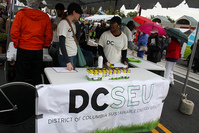Sustainable Energy Utility needs more than good intentions

Photo by Elvert Barnes on Flickr.
Malcolm Kenton wrote last week about the DC Sustainable Energy Utility’s progress toward helping DC residents and businesses save energy. Here is a less sanguine view.
The DC Sustainable Energy Utility (SEU) was created with the best of intentions and much fanfare. Unfortunately, after more than $30 million dollars and nearly 3 years, DC SEU has had trouble even changing light bulbs effectively, and is lagging behind successful programs in other states.
Energy-efficiency programs around the country have successfully demonstrated ways to assure that communities invest in saving energy, but DC ranked only 29th among states in energy-efficiency programs in 2012, according to one recent analysis.
That’s not great, since many states in the South and Great Plains have terrible records. The District should be a leader, or at least emulate the best programs from around the nation.
For example, in Massachusetts, utilities work with local banks to provide 0% interest loans for homeowners and businesses for energy efficiency. This addresses a common and fundamental impediment to efficiency investments at scale: poor access to capital. The public sector’s upfront incentives to the banks make the 0% loans possible, which then leverages significant investment capital from the private sector.
Virginia offers basic and straightforward rebates for commercial building energy audits. These audits identify where a building is inefficient (from HVAC to lighting to operations) and catalyze efficiency investments. Once a commercial building owner sees a facility’s inefficiencies, and has information about what investments could pay for themselves in savings, they often make sustainable improvements without further incentives.
SEU isn’t meeting its goals
DC residents and businesses pay a small percentage of their electric and gas bills to support DC SEU. As a result, DC SEU raised $17.5 million this year and will raise $20 million next year.
The Vermont Energy Investment Cooperation, or VEIC, won a competitive bid from the District to operate DC SEU. Their contract has been renewed each year, but so far, VEIC is struggling.
In fiscal year 2012, DC SEU met just 2 of 6 performance benchmarks the District set for things like reducing energy or increasing renewable energy generation. Their goal was to reduce citywide electricity use by 45,000 megawatt-hours, but they only saved 21,000.
DC SEU even fell behind on creating green jobs, which is one of its main goals. The organization hired just 41 people in 2012, well below their goal of 53.
DC SEU claims that it saved DC residents and businesses $2.8 million in annualized energy costs, but it received $14 million in funding last year. For a group intended to be a “market catalyst,” this return on investment is disappointing.
It also counts spillover effects from its work, like customers who don’t participate in their programs but are still working to reduce their energy use. This method of measurement may be an industry standard, but it doesn’t really reflect DC SEU’s effectiveness.
Is the SEU trying to do what it takes?
Nor does the organization’s FY 2013 First Quarter report acknowledge any of DC SEU’s past shortcomings or the need for any improvements. While the report calls for “strategic enhancements to [their] programming,” there’s little description of anything other DC SEU’s existing efforts, like their programs to replace light bulbs and seal heating ducts.
If this is all the District wanted to do to improve energy efficiency, there was no need to create a new organization. It could have given the job to PEPCO and Washington Gas, which are perfectly capable of doing this kind of work. Meanwhile, DC SEU admits that natural gas consumption has actually increased due to their focus on replacing incandescent light bulbs with high-efficiency bulbs. The new bulbs give off less heat, which means that in the colder months, customers actually use more heating gas to hear their homes and businesses (but save energy in the summer on cooling.)
DC SEU wasn’t even trying to balance the modest impact of the lighting upgrades with other programs to reduce heating loads. They spent just $700,000 of the $2 million allocated for natural gas-related programs. Whether this is simply poor management, misplaced priorities, or both, this is clearly not a good sign.
What can be done?
DC SEU needs help. They aren’t meeting their goals and they aren’t fulfilling their legal obligation to District ratepayers. Meanwhile, the District Department of the Environment (DDOE), which manages the organization, has done little oversight. A lot of the relevant staff has turned over at DDOE. Plus, that agency’s main expertise is not in “big data” or the economics of financial leverage in the ways necessary to push the SEU toward bolder thinking and better results.
There’s already a strong market for compact fluorescents (and an emerging one for the the even newer LED bulbs). The amount of savings from bulbs is small compared to commercial space, which uses a vastly disproportionate share of energy. With incentives to focus on the greatest possible value, the SEU could do more with, for instance, energy audits for commercial space.
Mayor Gray’s sustainability plan puts forward an exciting and laudable vision for the District. It would be a shame if DC SEU doesn’t play a key role in making it a reality.
